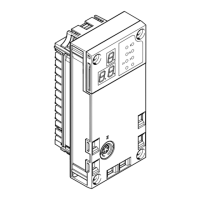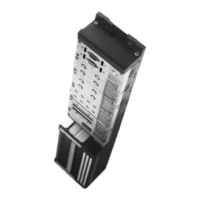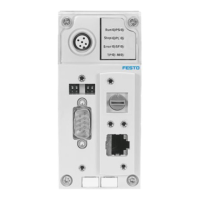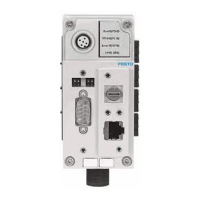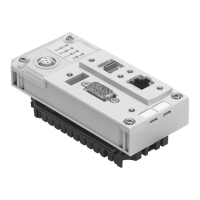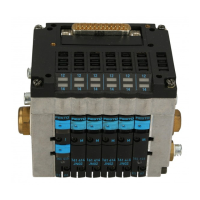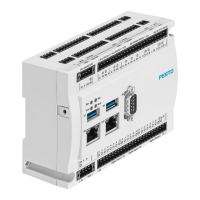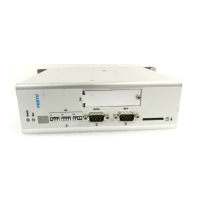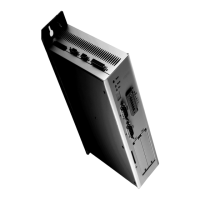Do you have a question about the Festo CPX-CMAX-C1-1 and is the answer not in the manual?
Planning considerations for parameterizing the CMAX axis controller.
Details on CPX nodes suitable for CMAX operation, including required versions and references.
Explains CMAX specific parameters and their storage location, inaccessible via standard interfaces.
Defines multi-byte value interpretation (INTEL/MOTOROLA) for CMAX and process values.
Covers fail-safe/idle mode parametrization and CPX terminal start-up behavior.
Provides an example for fail-safe or idle mode parametrization for I/O states.
Explains the correct procedure for CPX terminal parametrization during startup or after interruptions.
Outlines the process of commissioning the CMAX via the CPX node, recommending FCT.
Explains how operating modes affect I/O data content and accessible functions.
Details the record select mode, including information on records, processing, and limitations.
Describes direct operating mode where positioning tasks are formulated in PLC output data.
Outlines the commissioning mode for device operation, identification runs, and permitted functions.
Explains parameter transfer in cyclical I/O data and states for activating parametrization mode.
Provides a table summarizing functions available in different operating modes.
Details the structure of cyclical I/O data and the procedure for defining operating modes.
Explains the structure and assignment of CCON and SCON control and status bytes.
Describes how to define the operating mode using CCON.OPM1 and CCON.OPM2 control bytes.
Details the I/O data structure for the record select operating mode, including control and status bytes.
Explains the I/O data structure for direct operating mode, including control and status bytes.
Details the I/O data structure for commissioning mode, including control and status bytes.
Explains the I/O data structure for parametrising mode, including control and status bytes.
Illustrates the FHPP finite state machine with transitions between states.
Details the internal conditions and user actions for establishing ready status transitions.
Describes the positioning transitions and their internal conditions and user actions.
Summarizes special features for each operating mode related to specific transitions.
Provides a general overview of drive functions, including position and force control principles.
Explains single value mode (point-to-point) and automatic profile for position control.
Details how force control is achieved by regulating pressure forces and its properties.
Explains how standstill control starts after a positioning task, switching to force control.
Defines quality classes (Exact stop, Fast stop) for signaling task completion.
Describes controlling clamping units or brakes via digital output and control bits.
Defines Motion Complete (MC) and its rules for indicating task status.
Explains the dynamically updated controller status bits provided by the SPOS byte.
Discusses how CMAX limits setpoint values for acceleration to prevent overshoots.
Covers essential commissioning operations like movement tests and homing.
Explains the purpose and procedure of the movement test for detecting tubing connection defects.
Describes the necessity and process of homing for drives with incremental measuring systems.
Details the sequence for homing and related parameters.
Presents an overview of different homing methods oriented towards CANopenDS402.
Explains the process of identifying system parameters and automatic adaptation.
Describes the jog mode for traversing the drive in positive/negative directions.
Explains how to teach setpoint values, project zero point, and software end positions.
Details how records can be started in Drive enabled state for positioning profiles.
Describes the record start sequence involving PLC output data and CMAX acknowledgement.
Explains how a positioning task in record select mode is described by a record made of setpoint values.
Covers linking multiple records for automatic execution and defining switching conditions.
Explains direct operating mode where positioning tasks are formulated directly in I/O data.
Details the sequence of starting a positioning task in direct mode, including setpoint values and acknowledgements.
Describes continuous setpoint specification where the axis follows setpoint values.
Presents different options for diagnostics and error handling supported by CMAX.
Explains how CMAX monitors status and issues diagnostic messages categorized as faults or warnings.
Lists CPX error messages that can be evaluated via the CPX node or I/O diagnostic interface.
Explains the fault and warning grouping system based on cause and effect.
Classifies faults based on the CMAX response and effects on sequence control and axis.
Describes different reset types and their behavior upon fault acknowledgement.
Lists error and warning numbers with their causes, error handling, and types.
Details parameters for accessing current diagnostic messages and status.
Lists parameters for accessing current diagnostic messages, including bit-encoded faults and warnings.
Explains the diagnostic memory structure and how it stores recent events.
Describes fault status coding and additional information for diagnostics, supplementing error numbers.
Explains diagnostic events related to reset, switch-on, and configuration operations.
Covers settings to determine which diagnostic events are recorded and how faults are configured.
Outlines diagnostics accessible via I/O data, status bits, and I/O diagnostic interface.
Shows error messages represented by status bits in the CPX terminal.
Explains how diagnostic information is accessed via the I/O diagnostic interface and diagnostic memory.
Details how parameters can be changed via the I/O diagnostic interface using command box or acyclic services.
Describes the overall structure of CMAX parameters, grouped by category.
Covers mechanisms for protecting parameters from unauthorized access and modification.
Explains password protection to prevent unauthorized control or modification of parameters.
Discusses simultaneous operation of PLC and FCT and preventing FCT operation via CCON.LOCK.
Details locks to protect against maloperations during operating phase by changing parameters.
Explains the effects of transferring parameters on CCON.ENABLE and CCON.STOP signals.
Explains how default values can be used globally to specify positioning parameters.
Provides a comprehensive overview and description of all FHPP parameters.
Lists and categorizes all FHPP parameters with their properties.
Describes parameters related to manufacturer hardware, firmware, and FHPP versions.
Explains parameters for accessing diagnostic memory and events.
Explains parameters for position values, force values, pressure values, and command counts.
Describes parameters related to requested record number, actual record number, and record status byte.
Details parameters for project zero point, software end positions, and stop deceleration.
Lists parameters for jog mode speed, acceleration, deceleration, and workpiece mass.
Details parameters for direct mode positioning including base velocity, acceleration, deceleration, and tolerance.
Explains parameters for direct mode force control, including force ramp and workpiece mass.
Lists default values for speed, acceleration, deceleration, workpiece mass, and tolerance.
Covers parameters related to drive configuration like cylinder type, length, diameter, and measuring system.
Details parameters for application settings such as offset axis zero point and homing method.
Explains controller data parameters for position control like gain factor, cushioning, and filter factor.
Details parameters for force control, including gain factor, dynamic gain, filter factor, and timeout.
Covers parameters for identification settings and status.
Details parameters related to actual hardware configuration and analysis data.
Explains the Festo Parameter Channel (FPC) for transmitting parameters via cyclic I/O data.
Lists request and response identifiers, and error numbers for parameter transmission.
Outlines special rules for accessing the system of measurement and its limitations.
Describes how to transmit one parameter at a time using FPC in cyclic I/O data.
Provides an example of writing a setpoint position parameter using FPC.
Illustrates the sequence for cyclic parameter transmission using a flow chart.
Covers CPX module parameters and acyclic parameter exchange using function numbers.
Lists CPX module parameters and their corresponding function numbers for accessing data.
Explains standard module parameters and module configuration bytes used in startup parametrization.
Details acyclic functions in module parameters for executing functions via command box.
Explains the structure of parameter requests and responses for FPC function 1.
Covers preparations for commissioning, including checking the axis string and power supply.
Instructions for checking the complete system structure and electrical installation before commissioning.
Details the correct sequence for switching on power and compressed air, and switch-off procedures.
Provides step-by-step instructions for basic parametrization via CPX node.
Step-by-step guide for basic parametrization, including setting system of measurement and drive type.
Detailed steps for basic parametrization, including status checks and mode selection.
Explains how to parametrize the CMAX without hardware and the implications of no axis connection.
Describes the movement test for checking drive control direction and tube connections.
Outlines the functions of homing and identification after a successful movement test.
Covers operation and service aspects, including nominal/actual comparison and component exchange.
Explains how CMAX compares setpoint and actual configurations based on serial number transfer.
Details the CMAX response to component exchange and permissible deviations.
Explains how to modify hardware configuration data and delete axis data.
Describes three ways of resetting data in the CMAX: identification, axis, and device data reset.
Explains how to update CMAX firmware using the FCT PlugIn.
Describes the initial checks performed after switching on and power-down behavior.
Provides flow charts for CMAX control via I/O for typical applications.
Outlines requirements and notes for creating a ready status for the CMAX.
Illustrates the sequence for starting a record, including timing and acknowledgements.
Describes the procedure for resetting faults, including counter and timer mechanisms.
Explains how to switch between operating modes and the necessary feedback.
Explains how to operate CMAX in metric (SI) or imperial units and defines physical variables.
Details dimension reference systems for linear and swivel drives, including absolute and incremental types.
Explains system of units for linear drives with absolute measuring systems and reference points.
Describes system of units with incremental measuring systems and axis zero point definition.
Provides calculation rules for determining measuring reference system specifications for absolute and incremental systems.
Explains how software end positions are set within hardware limits and their parameterization.
Lists supported combinations of drive and measuring system types for CMAX.
Explains how to specify moving masses (workpiece, tool) for precise positioning.
Provides basic information on position control, including model path, identification, and adaptation.
Guides on checking system structure, mechanical connections, and pneumatic installation for optimal performance.
Steps to reduce system dynamics if compressed air supply is unstable to avoid overstressing.
Explains how to optimize controller parameters like amplification and filter factors for better performance.
Describes controller factors like amplification gain, cushioning factor, and signal filter factor for position control.
Provides guidance on optimizing positioning behavior when it does not meet expectations after identification.
Explains controller factors such as amplification gain, dynamic amplification, and signal filter for force control.
Details the basic principles of force control and standstill control, including reference values and calculations.
Explains how moving mass (workpiece, tool) affects force control and standstill force identification.
Discusses how mass influences standstill control and the conditions for reaching standstill.
Describes the behavior of force control, including force ramp, tolerance, and stop signal effects.
Explains how standstill control works after a positioning task and conditions for its activation.
Covers the use of individual value mode in record select and direct modes for force control.
Explains how position control is activated during a force task if setpoint speed is exceeded.
Details the force ramp calculation and its role in force control setpoint specification.
Discusses controller amplifications (gain, dynamic, filter) and their dependence on pneumatic system design.
Explains how static identification determines key parameters for force control.
Describes stroke, speed, and software end position monitoring functions during force control.
Provides notes on application and special operating statuses, including changing external forces.
Discusses how changes in external forces can cause vibration or bouncing on a stop.
Provides general information on the CPX-FB13 module.
Details module identifiers, occupied bytes, and device master file sources for CPX-FB13.
Guides on configuring CPX terminal modules, including adding DP master system and assigning addresses.
Explains the process of start parametrization for CPX terminals using default settings or specific parameters.
Illustrates assigning I/O addresses of the slave (CPX terminal) to PLC operands using RSNetworx.
Describes acyclical parameter access methods via command box or indirect tasks using FB13.
Provides general information on the CPX-FB11 (DeviceNet) module.
Guides on configuring DeviceNet station properties, including installing EDS files.
Demonstrates parameter setting using RSNetworx with modular EDS files.
Shows how to assign I/O addresses for DeviceNet configuration in RSNetworx.
Provides examples of error display in RSNetWorx for DeviceNet communication.
Provides general information on the CPX-FEC module and FST usage.
Guides on configuring CPX terminal with CPX-FEC using Festo Software Tools.
Explains that CMAX has no module parameters and demonstrates idle mode parametrization.
Instructs on saving changes permanently by saving actual configuration as nominal.
Provides an example of address assignment for the CPX-FEC terminal.
Explains how to perform diagnostics using the Hardware Configurator and online control panel.
Planning considerations for parameterizing the CMAX axis controller.
Details on CPX nodes suitable for CMAX operation, including required versions and references.
Explains CMAX specific parameters and their storage location, inaccessible via standard interfaces.
Defines multi-byte value interpretation (INTEL/MOTOROLA) for CMAX and process values.
Covers fail-safe/idle mode parametrization and CPX terminal start-up behavior.
Provides an example for fail-safe or idle mode parametrization for I/O states.
Explains the correct procedure for CPX terminal parametrization during startup or after interruptions.
Outlines the process of commissioning the CMAX via the CPX node, recommending FCT.
Explains how operating modes affect I/O data content and accessible functions.
Details the record select mode, including information on records, processing, and limitations.
Describes direct operating mode where positioning tasks are formulated in PLC output data.
Outlines the commissioning mode for device operation, identification runs, and permitted functions.
Explains parameter transfer in cyclical I/O data and states for activating parametrization mode.
Provides a table summarizing functions available in different operating modes.
Details the structure of cyclical I/O data and the procedure for defining operating modes.
Explains the structure and assignment of CCON and SCON control and status bytes.
Describes how to define the operating mode using CCON.OPM1 and CCON.OPM2 control bytes.
Details the I/O data structure for the record select operating mode, including control and status bytes.
Explains the I/O data structure for direct operating mode, including control and status bytes.
Details the I/O data structure for commissioning mode, including control and status bytes.
Explains the I/O data structure for parametrising mode, including control and status bytes.
Illustrates the FHPP finite state machine with transitions between states.
Details the internal conditions and user actions for establishing ready status transitions.
Describes the positioning transitions and their internal conditions and user actions.
Summarizes special features for each operating mode related to specific transitions.
Provides a general overview of drive functions, including position and force control principles.
Explains single value mode (point-to-point) and automatic profile for position control.
Details how force control is achieved by regulating pressure forces and its properties.
Explains how standstill control starts after a positioning task, switching to force control.
Defines quality classes (Exact stop, Fast stop) for signaling task completion.
Describes controlling clamping units or brakes via digital output and control bits.
Defines Motion Complete (MC) and its rules for indicating task status.
Explains the dynamically updated controller status bits provided by the SPOS byte.
Discusses how CMAX limits setpoint values for acceleration to prevent overshoots.
Covers essential commissioning operations like movement tests and homing.
Explains the purpose and procedure of the movement test for detecting tubing connection defects.
Describes the necessity and process of homing for drives with incremental measuring systems.
Details the sequence for homing and related parameters.
Presents an overview of different homing methods oriented towards CANopenDS402.
Explains the process of identifying system parameters and automatic adaptation.
Describes the jog mode for traversing the drive in positive/negative directions.
Explains how to teach setpoint values, project zero point, and software end positions.
Details how records can be started in Drive enabled state for positioning profiles.
Describes the record start sequence involving PLC output data and CMAX acknowledgement.
Explains how a positioning task in record select mode is described by a record made of setpoint values.
Covers linking multiple records for automatic execution and defining switching conditions.
Explains direct operating mode where positioning tasks are formulated directly in I/O data.
Details the sequence of starting a positioning task in direct mode, including setpoint values and acknowledgements.
Describes continuous setpoint specification where the axis follows setpoint values.
Presents different options for diagnostics and error handling supported by CMAX.
Explains how CMAX monitors status and issues diagnostic messages categorized as faults or warnings.
Lists CPX error messages that can be evaluated via the CPX node or I/O diagnostic interface.
Explains the fault and warning grouping system based on cause and effect.
Classifies faults based on the CMAX response and effects on sequence control and axis.
Describes different reset types and their behavior upon fault acknowledgement.
Lists error and warning numbers with their causes, error handling, and types.
Details parameters for accessing current diagnostic messages and status.
Lists parameters for accessing current diagnostic messages, including bit-encoded faults and warnings.
Explains the diagnostic memory structure and how it stores recent events.
Describes fault status coding and additional information for diagnostics, supplementing error numbers.
Explains diagnostic events related to reset, switch-on, and configuration operations.
Covers settings to determine which diagnostic events are recorded and how faults are configured.
Outlines diagnostics accessible via I/O data, status bits, and I/O diagnostic interface.
Shows error messages represented by status bits in the CPX terminal.
Explains how diagnostic information is accessed via the I/O diagnostic interface and diagnostic memory.
Details how parameters can be changed via the I/O diagnostic interface using command box or acyclic services.
Describes the overall structure of CMAX parameters, grouped by category.
Covers mechanisms for protecting parameters from unauthorized access and modification.
Explains password protection to prevent unauthorized control or modification of parameters.
Discusses simultaneous operation of PLC and FCT and preventing FCT operation via CCON.LOCK.
Details locks to protect against maloperations during operating phase by changing parameters.
Explains the effects of transferring parameters on CCON.ENABLE and CCON.STOP signals.
Explains how default values can be used globally to specify positioning parameters.
Provides a comprehensive overview and description of all FHPP parameters.
Lists and categorizes all FHPP parameters with their properties.
Describes parameters related to manufacturer hardware, firmware, and FHPP versions.
Explains parameters for accessing diagnostic memory and events.
Explains parameters for position values, force values, pressure values, and command counts.
Describes parameters related to requested record number, actual record number, and record status byte.
Details parameters for project zero point, software end positions, and stop deceleration.
Lists parameters for jog mode speed, acceleration, deceleration, and workpiece mass.
Details parameters for direct mode positioning including base velocity, acceleration, deceleration, and tolerance.
Explains parameters for direct mode force control, including force ramp and workpiece mass.
Lists default values for speed, acceleration, deceleration, workpiece mass, and tolerance.
Covers parameters related to drive configuration like cylinder type, length, diameter, and measuring system.
Details parameters for application settings such as offset axis zero point and homing method.
Explains controller data parameters for position control like gain factor, cushioning, and filter factor.
Details parameters for force control, including gain factor, dynamic gain, filter factor, and timeout.
Covers parameters for identification settings and status.
Details parameters related to actual hardware configuration and analysis data.
Explains the Festo Parameter Channel (FPC) for transmitting parameters via cyclic I/O data.
Lists request and response identifiers, and error numbers for parameter transmission.
Outlines special rules for accessing the system of measurement and its limitations.
Describes how to transmit one parameter at a time using FPC in cyclic I/O data.
Provides an example of writing a setpoint position parameter using FPC.
Illustrates the sequence for cyclic parameter transmission using a flow chart.
Covers CPX module parameters and acyclic parameter exchange using function numbers.
Lists CPX module parameters and their corresponding function numbers for accessing data.
Explains standard module parameters and module configuration bytes used in startup parametrization.
Details acyclic functions in module parameters for executing functions via command box.
Explains the structure of parameter requests and responses for FPC function 1.
Covers preparations for commissioning, including checking the axis string and power supply.
Instructions for checking the complete system structure and electrical installation before commissioning.
Details the correct sequence for switching on power and compressed air, and switch-off procedures.
Provides step-by-step instructions for basic parametrization via CPX node.
Step-by-step guide for basic parametrization, including setting system of measurement and drive type.
Detailed steps for basic parametrization, including status checks and mode selection.
Explains how to parametrize the CMAX without hardware and the implications of no axis connection.
Describes the movement test for checking drive control direction and tube connections.
Outlines the functions of homing and identification after a successful movement test.
Covers operation and service aspects, including nominal/actual comparison and component exchange.
Explains how CMAX compares setpoint and actual configurations based on serial number transfer.
Details the CMAX response to component exchange and permissible deviations.
Explains how to modify hardware configuration data and delete axis data.
Describes three ways of resetting data in the CMAX: identification, axis, and device data reset.
Explains how to update CMAX firmware using the FCT PlugIn.
Describes the initial checks performed after switching on and power-down behavior.
Provides flow charts for CMAX control via I/O for typical applications.
Outlines requirements and notes for creating a ready status for the CMAX.
Illustrates the sequence for starting a record, including timing and acknowledgements.
Describes the procedure for resetting faults, including counter and timer mechanisms.
Explains how to switch between operating modes and the necessary feedback.
Explains how to operate CMAX in metric (SI) or imperial units and defines physical variables.
Details dimension reference systems for linear and swivel drives, including absolute and incremental types.
Explains system of units for linear drives with absolute measuring systems and reference points.
Describes system of units with incremental measuring systems and axis zero point definition.
Provides calculation rules for determining measuring reference system specifications for absolute and incremental systems.
Explains how software end positions are set within hardware limits and their parameterization.
Lists supported combinations of drive and measuring system types for CMAX.
Explains how to specify moving masses (workpiece, tool) for precise positioning.
Provides basic information on position control, including model path, identification, and adaptation.
Guides on checking system structure, mechanical connections, and pneumatic installation for optimal performance.
Steps to reduce system dynamics if compressed air supply is unstable to avoid overstressing.
Explains how to optimize controller parameters like amplification and filter factors for better performance.
Describes controller factors like amplification gain, cushioning factor, and signal filter factor for position control.
Provides guidance on optimizing positioning behavior when it does not meet expectations after identification.
Explains controller factors such as amplification gain, dynamic amplification, and signal filter for force control.
Details the basic principles of force control and standstill control, including reference values and calculations.
Explains how moving mass (workpiece, tool) affects force control and standstill force identification.
Discusses how mass influences standstill control and the conditions for reaching standstill.
Describes the behavior of force control, including force ramp, tolerance, and stop signal effects.
Explains how standstill control works after a positioning task and conditions for its activation.
Covers the use of individual value mode in record select and direct modes for force control.
Explains how position control is activated during a force task if setpoint speed is exceeded.
Details the force ramp calculation and its role in force control setpoint specification.
Discusses controller amplifications (gain, dynamic, filter) and their dependence on pneumatic system design.
Explains how static identification determines key parameters for force control.
Describes stroke, speed, and software end position monitoring functions during force control.
Provides notes on application and special operating statuses, including changing external forces.
Discusses how changes in external forces can cause vibration or bouncing on a stop.
Provides general information on the CPX-FB13 module.
Details module identifiers, occupied bytes, and device master file sources for CPX-FB13.
Guides on configuring CPX terminal modules, including adding DP master system and assigning addresses.
Explains the process of start parametrization for CPX terminals using default settings or specific parameters.
Illustrates assigning I/O addresses of the slave (CPX terminal) to PLC operands using RSNetworx.
Describes acyclical parameter access methods via command box or indirect tasks using FB13.
Provides general information on the CPX-FB11 (DeviceNet) module.
Guides on configuring DeviceNet station properties, including installing EDS files.
Demonstrates parameter setting using RSNetworx with modular EDS files.
Shows how to assign I/O addresses for DeviceNet configuration in RSNetworx.
Provides examples of error display in RSNetWorx for DeviceNet communication.
Provides general information on the CPX-FEC module and FST usage.
Guides on configuring CPX terminal with CPX-FEC using Festo Software Tools.
Explains that CMAX has no module parameters and demonstrates idle mode parametrization.
Instructs on saving changes permanently by saving actual configuration as nominal.
Provides an example of address assignment for the CPX-FEC terminal.
Explains how to perform diagnostics using the Hardware Configurator and online control panel.
| Brand | Festo |
|---|---|
| Model | CPX-CMAX-C1-1 |
| Category | Controller |
| Language | English |
